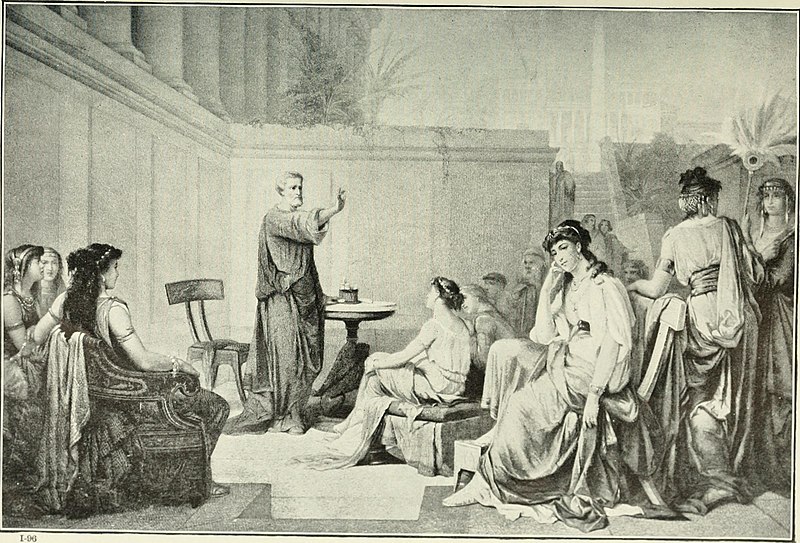
This is the fifth in a series of posts exploring infinity. There will be one infinity larger than another infinity, infinite perimeters, infinite regress, infinity paradoxes, an infinite set of bizarre things called cyclic numbers, and other infinity-related concepts.

Pythagoras (570 BCE – 490 BCE) is famous for his theorem which states that the square of the hypotenuse is equal to the sum of the squares on the other two sides. In the illustration above, one can see a right-angled triangle with three squares on its sides as part of an ever larger design with ever larger right-angled triangles. One could keep enlarging this forever and get an infinitely large design. One could also go in the opposite direction toward the infinitesimal. The design is also pictured in negative form next to it, and around the outside are graphic proofs of the Pythagorean Theorem, just a few of the hundreds of different known proofs of the theorem.
It should be noted that Pythagoras never claimed to have come up with the first proof of his famous theorem, and in fact the theorem had indeed been proved long before Pythagoras was born. A form of the theorem was known in China about a thousand years before the time of Pythagoras (and Pythagoras was born about 2600 years ago). It also happens to be the case that the area of a regular pentagon constructed on the hypotenuse of a right-angled triangle is equal to the sum of the areas of regular pentagons constructed on the other two sides of that triangle. The same is true of semicircles constructed on the sides of a right-angled triangle.

BERTRAND RUSSELL 1949
By Yousuf Karsh for Anefo – Nationaal Archief: entry a96fca82-d0b4-102d-bcf8-003048976d84, CC0, https://commons.wikimedia.org/w/index.php?curid=75100590
Pythagoras also devised and analysed the system we use to construct musical intervals. If you like music, thank Pythagoras. This was the first example of a description of a physical phenomenon mathematically so one could argue that Pythagoras invented Mathematical Physics. As a philosopher his ideas influenced philosophical giants such as Plato and Aristotle who came later. His ideas also influenced legendary scientists centuries later such as Copernicus, Kepler and Newton. In the twentieth century the great logician, mathematician and philosopher Bertrand Russell was an enthusiastic Pythagoras fanboy. Pythagoras came up with the Theory of Proportions, he was quite aware that the Earth was spherical, and he deduced that both the Evening Star and the Morning Star were both the same celestial object, i.e. the planet Venus. Despite his fame and influence, he lived so long ago that we don’t even know for sure when or where he died.

FROM A 1913 PAINTING
By Internet Archive Book Images – https://www.flickr.com/photos/internetarchivebookimages/14783288925/Source book page: https://archive.org/stream/storyofgreatestn01elli/storyofgreatestn01elli#page/n586/mode/1up, Public Domain, https://commons.wikimedia.org/w/index.php?curid=42033593
There are some nations today who refuse to allow women to get an education. When activist teenager Malala Yousafzai attempted to do something about that the Taliban shot her point blank in the head. She survived and went on to become the youngest recipient of the Nobel Peace Prize. About 2570 years ago Pythagoras of Samos formed a secret group of followers enthusiastically studying Mathematics and he welcomed women to join. 2570 years ago Pythagoras was more civilized than the Taliban today. We know of a least seventeen women who joined with Pythagoras.

MALALA YOUSAFZAI
By
内閣官房内閣広報室
– kantei.go.jp –
ユスフザイ女史による表敬及び共同記者発表
, CC BY 4.0, https://commons.wikimedia.org/w/index.php?curid=104706553
Here is another rendering of the figure in the illustration at the top of this post. I based this is illustration on a diagram by John Waterhouse published in July 1899, reprinted in The Pythagorean Proposition by Elias Loomis.:

PREVIOUS POSTS –
- Post 1 – https://thekiddca.wordpress.com/2024/04/06/infinities-infinity-everywhere/
- Post 2 – https://thekiddca.wordpress.com/2024/04/13/infinities-2-theres-no-business-like-snow-business/
- Post 3 – https://thekiddca.wordpress.com/2024/04/20/infinities-3-infinitesimal-chi-chiao-tu/
- Post 4 – https://thekiddca.wordpress.com/2024/04/27/infinities-4-no-vacancies-but-rooms-still-available-at-hotel-infinity/